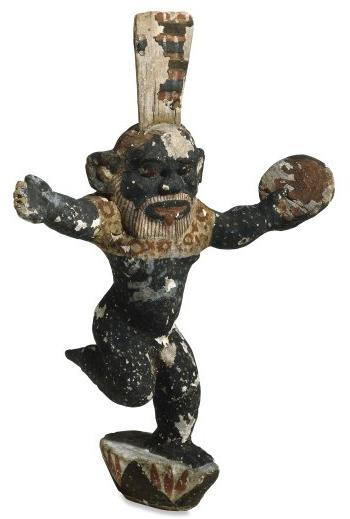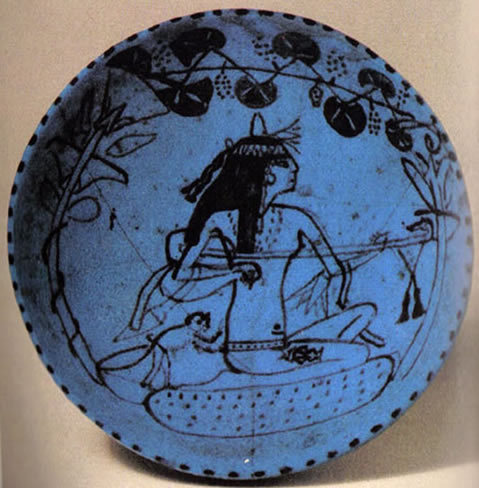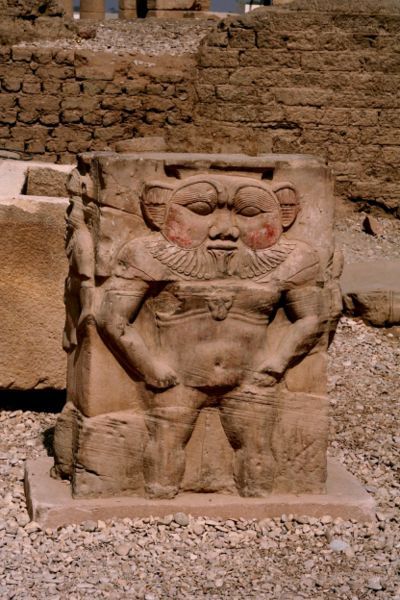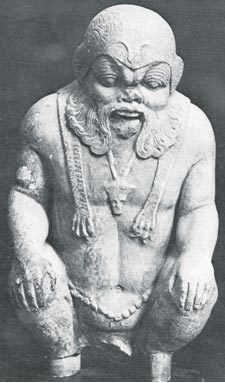
Bes From Thebes, Egypt 18th Dynasty

A musician with a tattoo of Bes

Bes relief at the Dendera Temple, Egypt

Bes Ibiza IBOSIM = The island of Bes.
nok-ind:
The African Diety Bes -From Central Africa To Kemet (Egypt).
The God Bes A guardian god. Bes was a foreign god, an import from the land of Nubia. He was jolly, fond of music, and dancing. He was a popular god who was adopted by the middle classes; he was considered a tutelary god of childbirth and, strangely enough, of cosmetics and female adornments. Bes chased away demons of the night and guarded men from dangerous animals. His image was carved on bedpost. He eventually became a protector of the dead and, amazingly, competed with even the refined and magnificent god Osiris for the attentions of men. He was originally the protective deity of the royal house of Egypt, but came to be a popular household deity throughout Egypt. Archeology Findings The oldest known fossil remains, according to Dr. Louis Leakey, were found in the Olduvai Gorge region in Kenya, Uganda and Tanzania. These first “small stature” people were known as the “Twa”, who worshipped the God Bes, a primitive human form of Horus I, being the earliest form of Ptah the God of Gods. The Twa, are modern humans or Homo sapiens sapiens. They are a diminutive Africoid people residing in the rain forests of Central Africa. Related groups live in South and Southeast Asia. We also find this same black God, Ptah, symbolized in the mystery system in Egypt. The Twa are said to have migrated the four thousand one hundred miles of the Nile river, establishing what was later to become the Egyptian civilization.
A Modern Theory of Language Evolution, by Carl J. Becker, 2004, p. 164 & 167: In Tanzania lie Lake Victoria, the Ngorongoro Crater and the Olduvai Gorge where the oldest known remains of the human species have been found. The north-south line of lakes, Albert, Ruranzige, Kivu, and Tanganyika, make the eastern edge of the Ituri Forest in Congo. The Efe Pygmies who live on the Ituri Forest called the Towering massif of Ruwenzori Baba Tiba, the Mountains of the Moon. In Efe theology the first man ascended to the heavens after serving as a benevolent governor of the primordial Pygmy nation. He then established residence on the moon where he still assists God by serving as the angel-of-the-moon. For tropical Black Africa the moon was, and still is, the favorite object of veneration, not the sun. Egyptian texts from around 2500 BC refer to the Pygmies as little men from the land of trees and spirits at the foot of the Mountains of the Moon. Egyptian king Nefrikare sent an expedition into central Africa and it returned with a dancing dwarf known as Akka. In the pyramid text of the sixth-dynasty monarch Pepi I it is declared that, “He who is between the thighs of Nut is the Pygmy who danceth like the god and who pleaseth the heart of the god before his great throne.” Nut was the goddess of heaven and the mother of Osiris. This Pygmy was called Bes. Page 167: We see, therefore, that it is physiology and genetics that tell us where our earliest ancestors came from; paleontology can only tell us where they went. Geneticist Douglas Wallace believes that Homo sapiens sapiens is descended from the ancestors of Baka Bambuke pygmies. Steven M. Stanley a paleontologist at Johns Hopkins supposes that hominids were forced out of the jungle environment by the cooler and drier climate of Earth by 2.5 millions years ago. Lucy’s group was probably part of this group. This would have been an Australopithecine version of the Twa Pygmies who live in the same general area around Lake Kivu on the eastern side of the Mountains of the Moon. The Twa have acclimated to life outside the Ituri Forest and are smiths, potters, and jack-of-all trades.
—————————————————————————————-
The Akka
That this race is an exceedingly ancient one is proved by the fact that Egyptologist Marriette Bey has discovered on a tomb of the ancient Empire of Egypt a figure of a dwarf with the name Akka inscribed by it.
Another Reference about the Twa people: Sako Ma: A Look at the Sacred Monkey Totem, By Matomah Alesha, Published 2004, Matam Press, pp. 35-36
Our oldest known human ancestor is a woman named Lucy. Her real name is unknown, but this is the name given to her by the archaeological team of Donald Johanson that uncovered her remains. The name Lucy is inspired by the Beetle’s song, Lucy in the Sky with Diamonds, which was heard while on an expedition. Lucy is dated to be, at least, 3.5 million years old. She is categorized as a species of Australopithecus afarensi. Her partial skeleton about the size of a chimpanzee was discovered in 1975. She has become known as one of the first Eves inhabiting ancient East Africa, although even still older fossils are being unearthed that push the date of the our original ancestor back even farther. Within the last 70 years, over 900 skeletons of prehominids are one hominid all dated at more then 1,000,000 years have been unearthed in Africa. ***** It is speculated that she was part of a clan, known variously in ancient and modern times as the Twa, Hottentot, Khoikhoi, San, Khmer, Bushmen, and Negrillos…The aboriginal peoples are found all over the world and form the basis of human culture…The aboriginal Twa are characterized by black to yellow skin, tightly curled hair (peppercorn), steatopygea (fat deposits in the rear-end) of some degree in women and men, full lips, elongated skull and a broad nose. They are short in stature and represent the mystical and mysterious short people documented in folklore and legend. The San, who are an extension of the Twa ancestors presently, live in the Kalahari Desert. The Twa descendants, however, live in rainforests and other remote areas around the world removed from modernization. This seed society gave birth to humanity both genetically and culturally.
On a side note: In Europe the Island Ibiza’s oldest name is Ibosim. Which translated from Punic language this word means “Island of Bes”.
Source: http://wysinger.homestead.com/bes.html

No comments:
Post a Comment